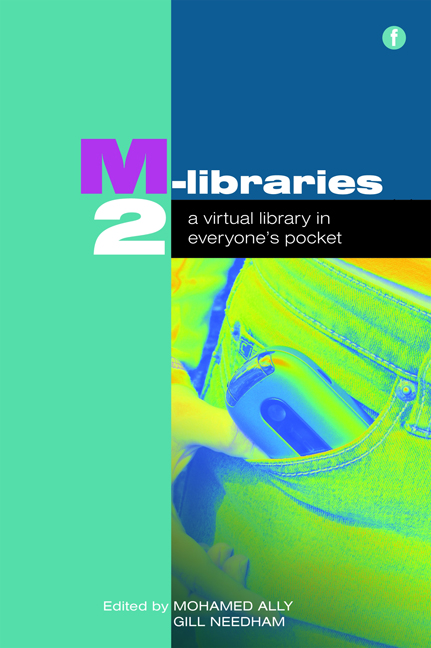Book contents
- Frontmatter
- Contents
- Acknowledgements
- Contributors
- Foreword
- Introduction
- PART 1 M-LIBRARIES: DEVELOPMENTS AROUND THE WORLD
- PART 2 TECHNOLOGY IN M-LIBRARIES
- 6 Evolution of modern library services: the progression into the mobile domain
- 7 Bibliographic ontology and e-books
- 8 QR codes and their applications for libraries: a case study from the University of Bath Library
- 9 A tale of two institutions: collaborative approach to support and develop mobile library services and resources
- 10 Designing a mobile device automatic detector to support mobile library systems
- 11 The Athabasca University Library Digital Reading Room: an iPhone prototype implementation
- PART 3 APPLICATION OF M-LIBRARIES
- PART 4 M-LIBRARIES AND LEARNING
- PART 5 BUILDING THE EVIDENCE BASE FOR M-LIBRARIES
- Conclusion
- Index
7 - Bibliographic ontology and e-books
from PART 2 - TECHNOLOGY IN M-LIBRARIES
Published online by Cambridge University Press: 08 June 2018
- Frontmatter
- Contents
- Acknowledgements
- Contributors
- Foreword
- Introduction
- PART 1 M-LIBRARIES: DEVELOPMENTS AROUND THE WORLD
- PART 2 TECHNOLOGY IN M-LIBRARIES
- 6 Evolution of modern library services: the progression into the mobile domain
- 7 Bibliographic ontology and e-books
- 8 QR codes and their applications for libraries: a case study from the University of Bath Library
- 9 A tale of two institutions: collaborative approach to support and develop mobile library services and resources
- 10 Designing a mobile device automatic detector to support mobile library systems
- 11 The Athabasca University Library Digital Reading Room: an iPhone prototype implementation
- PART 3 APPLICATION OF M-LIBRARIES
- PART 4 M-LIBRARIES AND LEARNING
- PART 5 BUILDING THE EVIDENCE BASE FOR M-LIBRARIES
- Conclusion
- Index
Summary
Abstract
This chapter consists of a theory paper on the conceptual model featured in the Functional Requirements for Bibliographic Records (FRBR) (IFLA, 1998) and its use in providing a framework for acquiring content used on mobile devices. FRBR is promulgated for the convenience of users of bibliographic systems. The paper is a proof of the concept that the IFLA bibliographic ontology remains a powerful tool for the conceptual understanding of a type of mobile digital content: e-books. The manifestation entity is of considerable significance for collecting e-content. (Previous work in this area includes theorization of items in a digital world (Manoff, 2006; Floyd and Renear, 2007).) The paper will present the idea of using this manifestation entity and the relationships it holds with other manifestation entities as a way to conceptualize digital content.
These issues can be understood in practice by drawing on the work of Tillett (1991), which enquired into the bibliographic relationships of works in cataloguing practice. In a study surveying multiple past cataloguing codes, Tillett (1991) found that cataloguing rules are cognizant of equivalent manifestations and make use of such bibliographic relationships in cataloguing practice. The significance of this paper is to present the FRBR conceptual model as a guide to collection developers.
Introduction to FRBR
The Functional Requirements for Bibliographic Records feature a conceptual model for helping librarians to articulate ‘what exists’ in the bibliographic world. This ontology is high level and terminological, rather than a more specific, assertional-level ontology. It defines the entities, attributes and relationships of the bibliographic universe. This definition is independent of any implementation or bibliographic system. One conceptual articulation of the FRBR ontology is made through an entity relation diagram (IFLA, 1998, 14). The entities of the bibliographic universe set forth are certainly understandable to the general library science practitioner. These definitions make sense in terms of thinking about what our users are asking for when they ask us to order forms of content that would seem to be novel to library and information science.
- Type
- Chapter
- Information
- M-Libraries 2A virtual library in everyone's pocket, pp. 73 - 80Publisher: FacetPrint publication year: 2010



